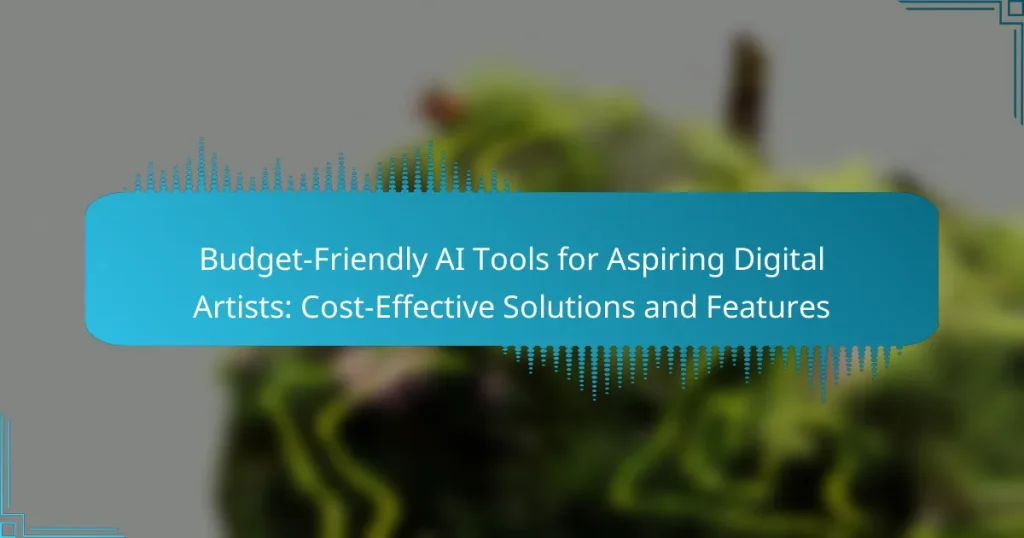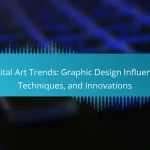For aspiring digital artists, budget-friendly AI tools can enhance creativity without breaking the bank. These cost-effective solutions provide essential features such as user-friendly interfaces, customizable brushes, and image manipulation capabilities, making them ideal for both beginners and professionals. By automating repetitive tasks and offering creative inspiration, these tools allow artists to focus on their vision while streamlining their workflow.
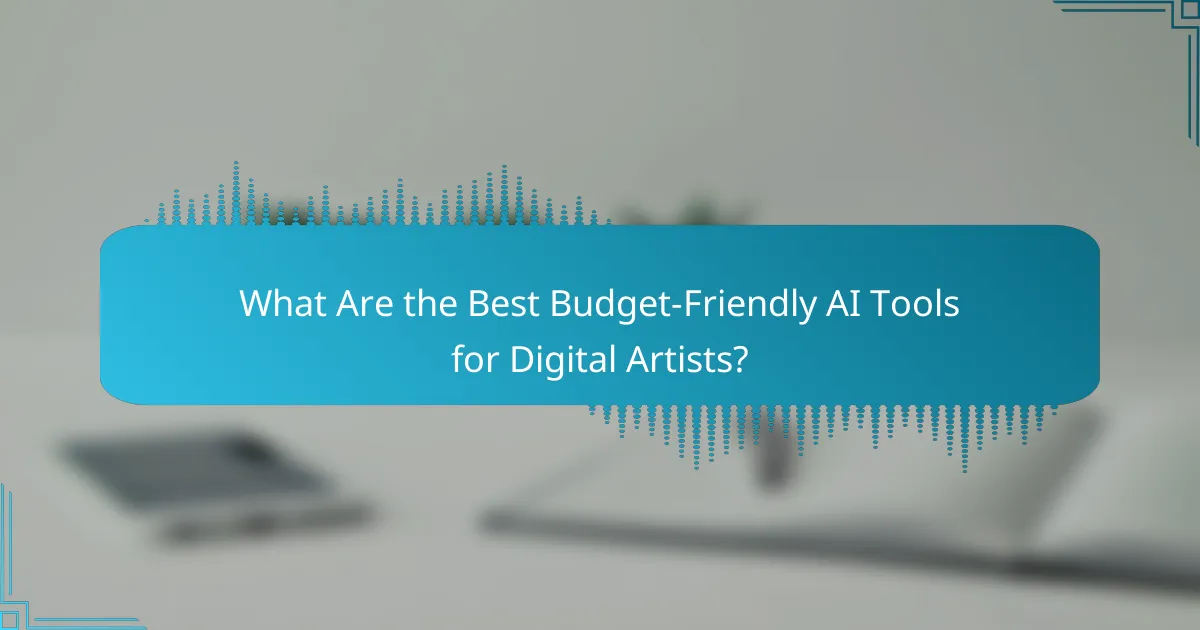
What Are the Best Budget-Friendly AI Tools for Digital Artists?
For aspiring digital artists, budget-friendly AI tools can enhance creativity without breaking the bank. These tools offer various features, from painting and illustration to image manipulation, making them accessible for beginners and professionals alike.
Adobe Fresco
Adobe Fresco is a powerful drawing and painting app designed for touch devices. It combines vector and raster graphics, allowing artists to create stunning illustrations with ease. The app offers a free version with essential features, while the premium subscription unlocks advanced tools and cloud storage.
Consider using Fresco for its live brushes that mimic real-life painting techniques. This feature is particularly useful for artists looking to experiment with watercolors or oils without the mess. The app is available for both iOS and Windows, making it versatile for different devices.
Artbreeder
Artbreeder is an innovative platform that uses AI to generate and remix images collaboratively. Users can blend different images to create unique artworks, making it an excellent tool for inspiration and experimentation. The basic version is free, while a subscription offers additional features and higher resolution downloads.
This tool is ideal for artists who want to explore diverse styles and concepts quickly. By adjusting parameters like color, shape, and style, you can create a wide range of visuals, from landscapes to character designs. Keep in mind that the community aspect allows for sharing and receiving feedback on your creations.
DeepArt
DeepArt leverages neural networks to transform photos into artworks in the style of famous artists. By uploading an image and selecting an artistic style, users can create unique pieces that blend personal photos with classic art styles. The service offers a free trial, but high-resolution outputs require payment.
When using DeepArt, consider experimenting with various styles to see how they alter your images. This tool is particularly useful for creating social media content or prints that stand out. However, be aware that the processing time can vary, so plan accordingly if you need quick results.
Canva
Canva is a user-friendly graphic design tool that incorporates AI features for creating stunning visuals. While primarily known for its templates and design elements, Canva also offers AI-driven tools for image enhancement and layout suggestions. The basic version is free, with a subscription available for additional features.
Canva is ideal for artists looking to create marketing materials or social media posts without extensive design skills. Its drag-and-drop interface simplifies the design process, making it accessible for beginners. However, be cautious of relying too heavily on templates, as this can limit your unique artistic expression.
Procreate Pocket
Procreate Pocket is a mobile version of the popular Procreate app, designed specifically for iPhone users. It offers a range of brushes, tools, and features that allow artists to create high-quality digital art on the go. While it requires a one-time purchase, it is relatively affordable compared to other professional-grade software.
This app is perfect for artists who want to sketch or paint anywhere. Its intuitive interface and extensive brush library provide a seamless experience for both beginners and experienced artists. Just be mindful of the device’s storage, as high-resolution artworks can take up significant space.

How Do These AI Tools Enhance Artistic Workflow?
AI tools significantly enhance artistic workflow by automating repetitive tasks, providing creative inspiration, and facilitating collaboration. These tools allow digital artists to focus more on their creative vision while streamlining processes like style application and image generation.
Automated Style Transfer
Automated style transfer enables artists to apply the visual style of one image to another, creating unique artworks quickly. This feature typically uses neural networks to analyze and replicate artistic styles, making it accessible for artists without extensive technical skills.
When using automated style transfer, consider the quality of the source images and the algorithms employed by the tool. Some tools may offer customization options, allowing you to adjust the intensity of the style applied, which can lead to more personalized results.
Image Generation Features
Image generation features allow artists to create original artwork from text prompts or existing images. These tools leverage machine learning models to generate visuals that can serve as inspiration or a base for further editing.
When selecting an image generation tool, evaluate the variety of styles and outputs it can produce. Many platforms offer free trials or tiered pricing, making it easy to experiment with different tools before committing financially.
Collaboration Tools
Collaboration tools facilitate teamwork among artists by providing shared workspaces and real-time feedback options. These features are essential for projects that require input from multiple creators, enhancing communication and efficiency.
Look for tools that integrate with popular design software and offer features like version control and comment threads. This can help streamline the creative process and ensure that all team members are aligned on project goals.
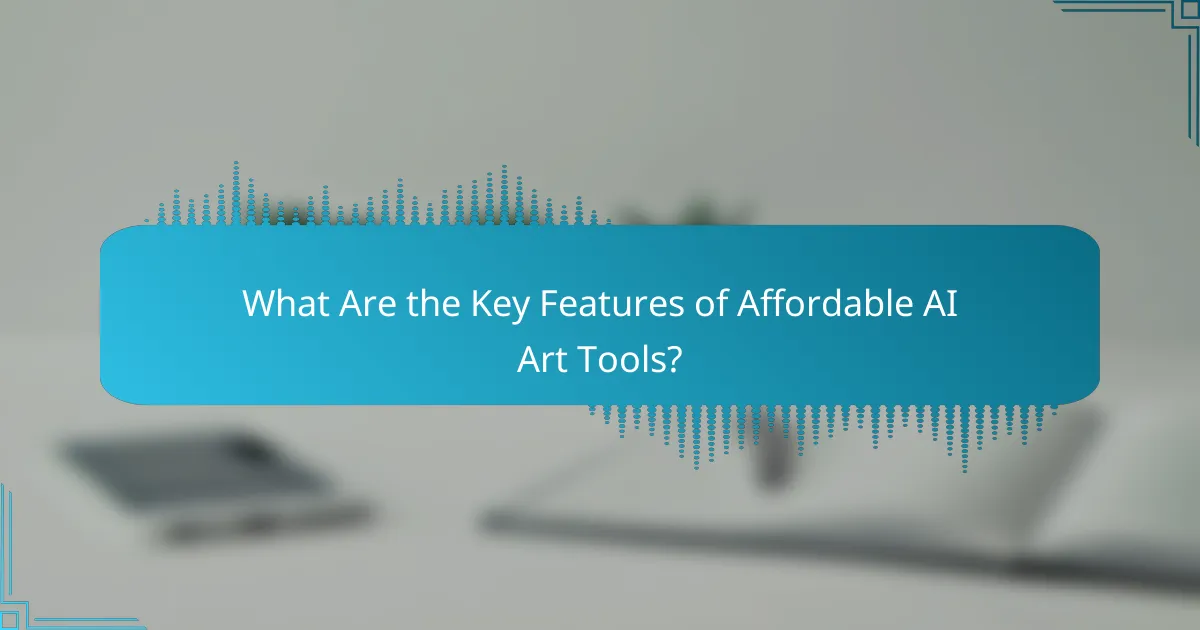
What Are the Key Features of Affordable AI Art Tools?
Affordable AI art tools typically offer essential features that enhance creativity without breaking the bank. Key aspects include user-friendly interfaces, customizable brushes, and cloud storage options, which collectively streamline the artistic process for aspiring digital artists.
User-Friendly Interfaces
User-friendly interfaces are crucial for artists, especially those new to digital art. These tools often feature intuitive layouts that simplify navigation, allowing users to focus on their creativity rather than struggling with complex menus.
Look for tools that provide customizable workspaces, enabling you to arrange tools and panels according to your preferences. This can significantly enhance your workflow and make the creative process more enjoyable.
Customizable Brushes
Customizable brushes are a vital feature in affordable AI art tools, allowing artists to create unique textures and styles. Many tools offer a range of brush settings, such as size, opacity, and hardness, which can be adjusted to suit individual artistic needs.
When selecting a tool, consider those that provide a library of pre-made brushes alongside the option to create your own. This flexibility can help you achieve a distinct artistic style while saving time on repetitive tasks.
Cloud Storage Options
Cloud storage options are increasingly common in budget-friendly AI art tools, providing artists with a secure way to save and access their work from anywhere. This feature is particularly beneficial for those who work on multiple devices or collaborate with others.
Choose tools that offer seamless integration with popular cloud services, ensuring your artwork is backed up and easily shareable. Be mindful of any storage limits or subscription fees associated with additional space, as these can impact your overall budget.

How Do Pricing Models Compare for Digital Art Tools?
Digital art tools offer various pricing models that cater to different budgets and user needs. Understanding these models can help aspiring digital artists choose the most cost-effective solution for their creative endeavors.
Subscription-Based Models
Subscription-based models charge users a recurring fee, typically monthly or annually, for access to software and updates. This approach allows artists to use the latest features without large upfront costs, making it easier to budget over time.
Popular tools like Adobe Creative Cloud and Corel Painter use this model, with prices often ranging from $10 to $60 per month. While subscriptions can provide ongoing support and updates, artists should consider their long-term usage to avoid paying more than necessary.
One-Time Purchase Options
One-time purchase options require a single payment for lifetime access to the software, which can be appealing for those who prefer not to commit to ongoing fees. This model often results in lower total costs for users who do not need frequent updates.
Examples include Clip Studio Paint and Paint Tool SAI, which typically range from $50 to $200. However, users should be aware that one-time purchases may not include future updates or support, which could lead to additional costs down the line.
Freemium Models
Freemium models provide basic features for free, with optional paid upgrades for advanced tools or functionalities. This allows aspiring artists to experiment with software without financial commitment, making it a great entry point.
Tools like Krita and Medibang Paint offer robust free versions, while premium features may cost between $5 and $30. Artists should evaluate whether the free version meets their needs before deciding to invest in upgrades, ensuring they get value for their money.
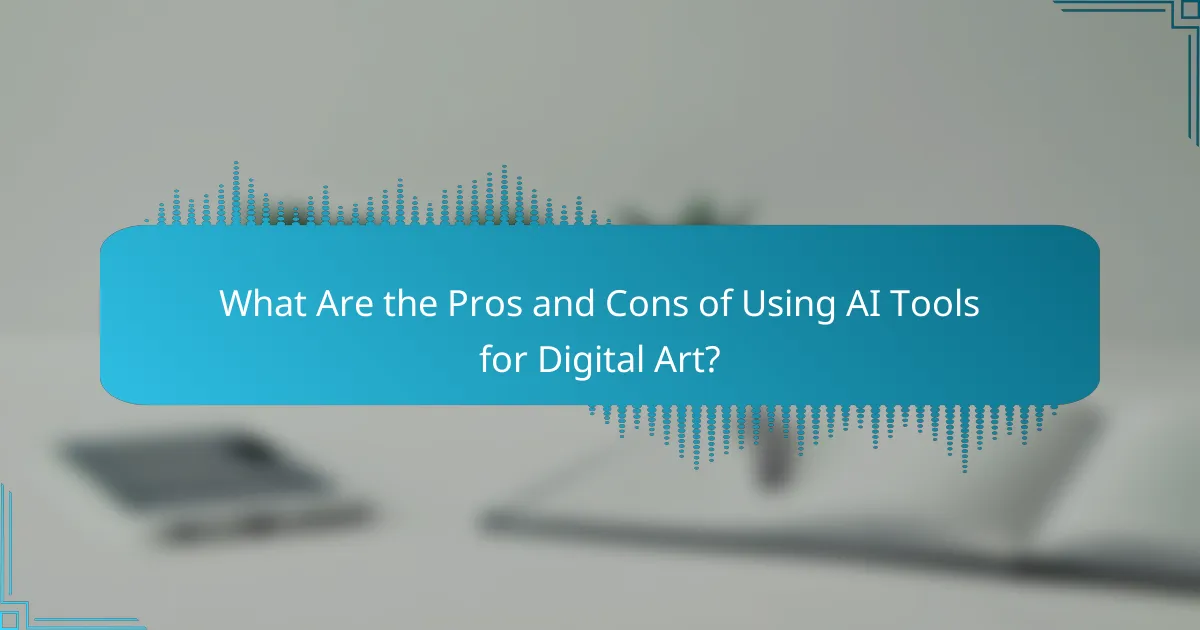
What Are the Pros and Cons of Using AI Tools for Digital Art?
AI tools for digital art offer significant advantages and some drawbacks. They can enhance creativity and streamline workflows, but may also impose limitations on artistic expression and require time to master.
Time-Saving Benefits
One of the primary advantages of AI tools is their ability to save time. Tasks such as image generation, background removal, and colorization can be completed in a fraction of the time it would take manually. For instance, an AI tool might generate a complex image in minutes, whereas traditional methods could take hours or even days.
Additionally, these tools often automate repetitive tasks, allowing artists to focus on more creative aspects of their work. This efficiency can lead to increased productivity, enabling artists to produce more pieces in a shorter timeframe.
Creative Limitations
While AI tools can enhance creativity, they also come with certain limitations. Many AI-generated artworks may lack the unique touch that comes from human creativity, leading to a more formulaic style. Artists might find themselves relying too heavily on AI, which can stifle personal growth and experimentation.
Furthermore, some AI tools may not fully understand artistic nuances, resulting in outputs that don’t align with the artist’s vision. It’s essential for artists to balance AI assistance with their own creative input to maintain originality.
Learning Curve Challenges
Adopting AI tools often involves a steep learning curve. Artists may need to invest time in understanding how to use these technologies effectively, which can be daunting for beginners. Familiarizing oneself with various features and functionalities is crucial for maximizing the benefits of these tools.
Moreover, the rapid evolution of AI technology means that artists must stay updated with the latest advancements. This ongoing learning process can be both time-consuming and overwhelming, especially for those who are already managing multiple projects.
